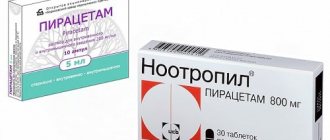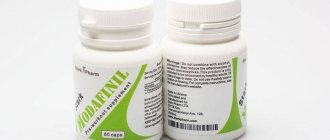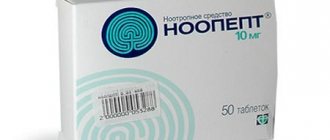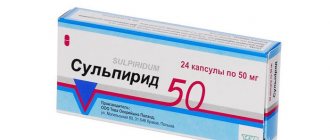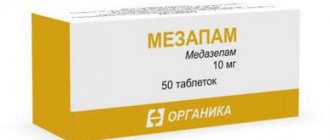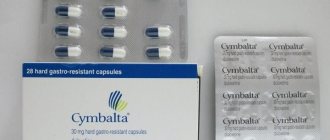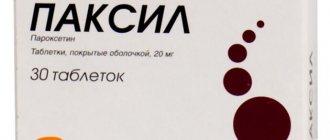Nardil (aka Phenelzine) is one of the most powerful monoamine oxidase (MAO) inhibitors and belongs to the group of antidepressants.
This drug is used to treat depressive and phobic disorders in humans caused by various factors. It is prescribed to relieve anxiety symptoms in cases where other means have failed.
Nardil is available in the form of tablets, which must have an expiration date indicated on them. The active ingredient is Phenelzine. This drug also contains active compounds and special formative components that help treat depression and complex neurological diseases. An antidepressant can only be purchased with a prescription from your doctor.
Pharmacological profile
Drugs from the group of MAO inhibitors contain biologically active substances that can inhibit an enzyme such as monoamine oxidase.
The drug Nardil was created specifically to block the destruction of substances such as serotonin and norepinephrine, allowing them to increase their amount. This improves the transmission of nerve impulses in the central nervous system.
One of the main features of this medicine is that it has a fairly long period of pharmacological action. This is due to the fact that the effect after using the drug can last about 2-4 weeks.
Often, antidepressants have a significant difference in the duration of removal of the drug from the body.
Nardil is a medication, the dose of which must be constantly increased during treatment.
Initially, the course of treatment begins with a minimum dosage (5 mg) and increases depending on the results of treatment. The maximum safe dose is 90 mg, in extreme exceptional cases it reaches 170 mg.
The period of removal of active components from the body can vary from several hours to several days, depending on the characteristics of a particular person (gender, age, health status).
The average time for removal of 30 mg of medication from the body is approximately 11.5 hours.
Pharmacological properties of the drug "Selegiline"
The drug is produced under the trade name Selegilin AL by the German pharmaceutical company Aliud Pharma. The corporation is one of the world's largest manufacturers of high-quality generics. In 1996, the company became a structural division of the pharmaceutical corporation Stada Group.
As the instructions for use indicate, Selegiline is an antiparkinsonian drug, a selective MAO-B inhibitor that is involved in the metabolism of catecholamines and dopamine. This drug inhibits the metabolism of dopamine, its reuptake at the level of presynaptic nerve endings, which increases its concentration in the nuclei of the extrapyramidal system and other parts of the brain.
What is the mechanism of action of Selegiline? A single dose of 5 mg of this medication inhibits 50% of MAO in the central nervous system. Enzyme recovery time is 2 weeks. In therapeutic dosages, it has no effect on intestinal MAO and does not contribute to the breakdown of tyramine that enters the body with food.
Indications and contraindications for use
MAO inhibitors (like Nardil, in particular) are used to treat the following diseases:
- nervous disorders accompanied by anxiety and restlessness;
- depression of various origins;
- the drug is prescribed to patients who have a mild form of depression accompanied by increased anxiety, fears, apathy, as well as the occurrence of many phobias.
Nardil helps normalize the level of aminobutyric acid and a very important substance - serotonin. Thanks to this, the anxiety that arises goes away over time, and the main symptoms of its manifestation also disappear.
The medication has a number of contraindications, so you must follow the recommendations of your doctor. The main contraindications for prescribing the drug are:
- individual intolerance to any component of the drug;
- cannot be used in patients with alcoholism;
- In addition, the drug should never be used by pregnant women or breastfeeding mothers;
- acute kidney and liver diseases;
- heart failure;
- age less than 18 years.
Perphenazine: drug interactions
The simultaneous use of the drug Perphenazine and drugs that depress the central nervous system (barbiturates, tranquilizers, anesthesia drugs, narcotic analgesics, alcohol) increases depression of the central nervous system and inhibits breathing.
The combination of Perphenazine and tricyclic antidepressants, MAO inhibitors, maprotiline threatens to increase the risk of developing neuroleptic malignant syndrome.
The use of Perphenazine with anticonvulsants may lead to a weakening of the effect of the latter and a decrease in the seizure threshold.
The simultaneous use of Perphenazine and drugs that cause the development of extrapyramidal reactions leads to an increase in the severity of extrapyramidal disorders.
Taking antihypertensive drugs while using Perphenazine leads to an increase in their hypotensive effect, which may result in orthostatic hypotension.
Perphenazine may weaken the vasoconstrictor effect of ephedrine.
The simultaneous use of Perphenazine and adrenaline is contraindicated, as it leads to a distortion of the effect of the latter, resulting in a decrease in blood pressure.
Taking the drug Perphenazine and Levodopa leads to a decrease in its antiparkinsonian effect. Perphenazine inhibits the effect of clonidine, amphetamines and guanethidine.
Taking Perphenazine leads to an increase in the anticholinergic effect of other drugs, while a decrease in its antipsychotic effect is observed.
With the simultaneous use of Perphenazine and prochlorperazine, the patient may experience prolonged loss of consciousness.
The combination of Perphenazine with adsorbing antidiarrheals is undesirable.
Instructions for use
Nardil tablets are taken orally, washed down with water, which must first be boiled and cooled.
It is very important that they must be consumed whole, not split or snacked. As for the dosage, it is selected exclusively individually, so the amount can vary from 5 mg to 90 mg per day. Usually the entire prescribed dosage is divided into two or three doses per day.
After starting treatment, the doctor must conduct an examination and establish an effective dose for a particular patient. The result after starting to take the medicine can be noticeable only after 2 weeks, but sometimes after one month.
Depending on the severity of the depressive state and nervous disorders, the drug is prescribed only after consultation with a doctor.
The duration of treatment can range from several months to several years. Withdrawal of an antidepressant should occur by gradually reducing the dose of the drug, this is due to the fact that after abruptly stopping the drug, relapses (withdrawal syndrome) may occur. Therefore, refusal to take an antidepressant should always be agreed with your doctor.
Pharmacy without borders
Nardil - Phenelzine is one of the most powerful monoamine oxidase (MAO) inhibitors and belongs to the group of antidepressants. The drug is used to treat depressive and phobic disorders in humans caused by various factors. It is prescribed to relieve anxiety symptoms in cases where other means have failed. It is produced in the form of tablets, on which the expiration date must be indicated. The active ingredient is Phenelzine. This drug also contains active compounds and special formative components that help treat depression and complex neurological diseases.
Pharmacological profile
Drugs from the group of MAO inhibitors contain biologically active substances that can inhibit an enzyme such as monoamine oxidase. The drug NARDIL - Phenelzine was created specifically to block the destruction of substances such as serotonin and norepinephrine, allowing them to increase their quantity. This improves the transmission of nerve impulses in the central nervous system. One of the main features of the medicine is that it has a fairly long period of pharmacological action. This is due to the fact that the effect after using the drug can last about 2-4 weeks. Often, antidepressants have a significant difference in the duration of removal of the drug from the body. Nardil - Phenelzine is a medication, the dose of which must be constantly increased during treatment. Initially, the course of treatment begins with a minimum dosage (5 mg) and increases depending on the results of treatment. The maximum safe dose is 90 mg, in extreme exceptional cases it reaches 170 mg. The period of removal of active components from the body can vary from several hours to several days, depending on the characteristics of a particular person (gender, age, health status).
Indications and contraindications for use
MAO inhibitors are used to treat the following diseases: nervous disorders accompanied by anxiety and restlessness; depression of various origins; the drug is prescribed to patients who have a mild form of depression accompanied by increased anxiety, fears, apathy, as well as the occurrence of many phobias. NARDIL - Phenelzine helps normalize the level of aminobutyric acid and a very important substance - serotonin. Thanks to this, the anxiety that arises goes away over time, and the main symptoms of its manifestation also disappear. The medication has a number of contraindications, so you must follow the recommendations of your doctor. The main contraindications for prescribing the drug are: individual intolerance to any component of the drug; cannot be used in patients with alcoholism; In addition, the drug should never be used by pregnant women or breastfeeding mothers; acute kidney and liver diseases; heart failure; age less than 18 years.
Instructions for use
Nardil - Phenelzine tablets are taken orally, washed down with water, which must first be boiled and cooled. It is very important that they must be consumed whole, not split or snacked. As for the dosage, it is selected exclusively individually, so the amount can vary from 5 mg to 90 mg per day. Usually the entire prescribed dosage is divided into two or three doses per day. After starting treatment, the doctor must conduct an examination and establish an effective dose for a particular patient. The result after starting to take the medicine can be noticeable only after 2 weeks, but sometimes after one month. Depending on the severity of the depressive state and nervous disorders, the drug is prescribed only after consultation with a doctor. The duration of treatment can range from several months to several years. Withdrawal of an antidepressant should occur by gradually reducing the dose of the drug, this is due to the fact that after abruptly stopping the drug, relapses (withdrawal syndrome) may occur. Therefore, refusal to take an antidepressant should always be agreed with your doctor.
Adverse reactions and cases of overdose
The use of the antidepressant NARDIL - Phenelzine can lead to many side effects, including: excessive drowsiness; the occurrence of headaches or dizziness; in addition, there is a high probability of blood pressure disturbances, and cardiac arrhythmia is not excluded; nausea and frequent vomiting; dry mouth or visual impairment; quite rare, but sometimes there are cases of manic state; Side effects may occur due to the use of this antidepressant with alcohol, so you should avoid using it during the course of treatment for depression. In addition, the drug should not be taken during pregnancy, since the components it contains may adversely affect the health of the unborn child. Use during pregnancy may cause premature birth. And after the birth of a child, there is a high probability of difficulties for the child to adapt to the world around him. As for an antidepressant overdose, the consequences can be quite dire if the necessary measures are not taken. If the patient was careless to take an unsafe dosage, then you must first rinse his stomach and be sure to call a doctor.
special instructions
To avoid side effects when taking it, you must adhere to a strict diet. It lies in the fact that from your diet you need to exclude all foods that contribute to the accumulation of such a substance as tyramine. Therefore, you should not consume the following products: wine, other alcoholic beverages; cheeses, dairy products; meat, canned meat; nuts; products with preservatives; fatty foods. In addition, NARDIL - Phenelzine should not be taken with medications that may react with this drug, for example, cold or cough medicines. Failure to follow a diet and the concomitant use of other medications can have an extremely negative impact on health, which is manifested by sudden changes in blood pressure, as well as an increase in heart rate.
Adverse reactions and cases of overdose
The use of the antidepressant Nardil can lead to many side effects, including:
- excessive sleepiness;
- the occurrence of headaches or dizziness;
- in addition, there is a high probability of blood pressure disturbances, and cardiac arrhythmia is not excluded;
- nausea and frequent vomiting;
- dry mouth or visual impairment;
- quite rare, but sometimes there are cases of manic state;
In addition, the drug should not be taken during pregnancy, since the components it contains may adversely affect the health of the unborn child.
Use of Nardil during pregnancy may cause premature birth. And after the birth of a child, there is a high probability of difficulties for the child to adapt to the world around him.
As for an antidepressant overdose, the consequences can be quite dire if the necessary measures are not taken. If the patient was careless to take an unsafe dosage, then you must first rinse his stomach and be sure to call a doctor.
pharmachologic effect
Belongs to the group of sympathomimetic amines that, like mezaton, stimulate alpha-adrenergic receptors.
Compared to mezaton, it causes a slightly less sharp, but more prolonged increase in blood pressure.
The introduction of fethanol into the conjunctival sac (the cavity between the back surface of the eyelids and the front surface of the eyeball) causes a slight dilation of the pupil and a decrease in intraocular pressure (mainly due to a decrease in the formation of aqueous humor).
special instructions
To avoid side effects when taking Nardil, you must adhere to a strict diet. It lies in the fact that from your diet you need to exclude all foods that contribute to the accumulation of such a substance as tyramine. Therefore, you should not consume the following products:
- wine, other alcoholic drinks;
- cheeses, dairy products;
- meat, canned meat;
- nuts;
- products with preservatives;
- fatty foods.
In addition, Nardil should not be taken with medications that may react with this drug, for example, cold or cough medicines.
Failure to follow a diet and the concomitant use of other medications can have an extremely negative impact on health, which is manifested by sudden changes in blood pressure, as well as an increase in heart rate.
I have an opinion
Reviews from patients who have undergone or are undergoing treatment with Nardil.
I developed depression at the age of 30 after experiencing terrible personal events. I have been taking Nardil for more than 16 years and I feel much more confident, and most importantly, my fears and anxiety have disappeared. Today I take 75 mg per day, but I need to gradually increase the dose.
Mikhail, Moscow
My depression began 21 years ago, after serious everyday problems. My doctor prescribed Phenelzine for me and prescribed a dose of 10 mg with a gradual increase to 40 mg. It was after this that my legs began to swell.
When I reduced the dose, the swelling in my legs decreased, but it never went away completely. I am thinking that it is worth replacing this drug with another one.
Alexander, Murmansk
I was very lucky with my doctor; he prescribed this drug for me, and I am very pleased with its results. My depression has gone away, my anxiety has disappeared, which allows me to be a confident woman. As for food restrictions, it's not so bad, because I now eat healthy food, which also has a beneficial effect on my health.
Marina, Ekaterinburg
Reviews
Anatoly, 45 years old
My eldest daughter had a weak stage of ADHD, she studied poorly, had difficulty mastering the school curriculum, and because of this she had complexes and suffered from neuroses. The doctor prescribed this psychostimulant, we took it strictly as prescribed, there were practically no side effects, sometimes nausea and headache occurred. An effective product, I recommend it.
Natalya, 32 years old
My 14 year old son takes the drug. I didn’t notice any changes in consciousness or drug effects after taking the pills, but the effect was obvious – the child became calm, balanced, focused on school, and less irritable. The cost of the product is quite reasonable. The main thing is to follow your doctor's advice.
Marina, 45 years old
My psychotherapist periodically prescribes these pills to me. I am a knowledge worker, a creative person, I am at my work place 12 - 14 hours a day, 6 - 7 days a week, I am very tired morally, physically, emotionally. To keep myself in good shape and not fall into depression, I take this medicine.
Purchase question
You cannot officially buy Nardil on the territory of the Russian Federation, but you can order it online abroad; the drug is also offered on various specialized forums, where its price ranges from 600 to 1100 rubles per package.
Registration number:
Trade name: PHENYLIN
International nonproprietary name: phenindione
Dosage form:
Compound
1 tablet contains: active substance: phenindione 0.03 g; Excipients: milk sugar, starch, talc, citric acid.
Description: tablets of white or off-white color, flat-cylindrical, with a bevel.
Pharmacotherapeutic group:
ATX CODE: B01AA02.
Pharmacological properties Pharmacodynamics: Phenyline refers to drugs that affect blood clotting, indirect anticoagulants. It causes hypoprothrombinemia, caused by a disruption in the formation of prothrombin in the liver, and also reduces the formation of factors VII, IX and X. The cumulative effect of phenylin is greater than that of neodicoumarin. When taken orally, a decrease in the concentration of blood coagulation factors occurs 8-10 hours after taking phenyline and reaches a maximum after 24-30 hours. Pharmacokinetics: After oral administration, it is quickly and almost completely absorbed. It passes through histo-hematological barriers and accumulates in tissues. Metabolized in the liver. It is excreted by the kidneys unchanged and in the form of metabolites.
Side effects
From the blood coagulation system: with long-term use - micro- and macrohematuria, bleeding from the oral cavity and nasopharynx, gastrointestinal bleeding, hemorrhage into the muscles. From the blood system: inhibition of bone marrow hematopoiesis (agranulocytosis, leukopenia, leukemoid reactions). From the digestive system: nausea, diarrhea, toxic hepatitis. From the cardiovascular system: myocarditis. Allergic reactions: skin rash (erythematous, macular, papular), exfoliative dermatitis, eosinophilia, hyperthermia. From the urinary system: impaired renal function, pink colored urine. Other: headache, orange discoloration of palms.
Contraindications
Contraindications to the use of the drug Fenilin are: increased individual sensitivity to the components of the drug, hemophilia, severe hepatic and/or renal failure, hemorrhagic diathesis, hypocoagulation (initial prothrombin level less than 70%), malignant neoplasms, erosive and ulcerative lesions of the gastrointestinal tract, period pregnancy (especially the first trimester and the second half of the third trimester), breastfeeding period, childhood.
Overdose
Symptoms of Phenilin : hemorrhagic syndrome (gastrointestinal, uterine, nosebleeds, hematuria, hemorrhages in the skin, muscles, parenchymal organs). Treatment: drug withdrawal; taking vitamin K orally (5 – 10 mg). If serious bleeding develops, vitamin K is administered intravenously slowly (1 mg/min) in a total dose of 10–50 mg (normalizes the increased prothrombin time within 6 hours). In case of massive bleeding or in patients with liver failure, fresh frozen plasma is simultaneously prescribed. It is possible to use aminocaproic acid, vitamins C and P.
Zenix
Suction
The maximum concentration (Cmax) and minimum concentration (Cmin) of linezolid in blood plasma at steady state after intravenous administration twice a day at a dose of 600 mg were 15.1 mg/L and 3.68 mg/L, respectively. The equilibrium concentration of linezolid in the blood is achieved on the 2nd day of drug administration.
Distribution
The volume of distribution of linezolid when equilibrium concentration is reached in a healthy adult averages 40-50 L, which is approximately equal to the total body water content. Plasma protein binding is 31% and is independent of the concentration of linezolid in the blood.
Metabolism
It has been established that cytochrome P450 isoenzymes are not involved in the metabolism of linezolid in
vitro .
Linezolid does not inhibit or potentiate the activity of clinically important cytochrome P450 isoenzymes (1A2, 2C9, 2C19, 2D6, 2E1.3A4).
Metabolic oxidation leads to the formation of two inactive metabolites - hydroxyethylglycine (the main metabolite in humans, formed as a result of a non-enzymatic process), and aminoethoxyacetic acid (formed in smaller quantities). Other inactive metabolites have also been described.
Removal
Extrarenal clearance accounts for approximately 65% of linezolid clearance. As the dose of linezolid increases, a slight degree of nonlinearity in clearance is observed. This may be explained by decreased renal and extrarenal clearance with high doses of linezolid. However, differences in clearance are small and do not affect the apparent half-life.
Linezolid in patients with normal renal function and with mild to moderate renal failure is excreted by the kidneys in the form of hydroxyethylglycine (40%), aminoethoxyacetic acid (10%) and unchanged (30-35%). The intestines are excreted in the form of hydroxyethylglycine (6%) and aminoethoxyacetic acid (3%).
In unchanged form, linezolid is practically not excreted by the intestines. The half-life of linezolid averages 5-7 hours.
Pharmacokinetics in selected patient groups
Patients with kidney failure
After a single administration of 600 mg of the drug to patients with severe renal failure (creatinine clearance <30 ml/min), the concentration of its two main metabolites increased 7-8 times. However, no increase in the area under the concentration-time curve (AUC) of the parent drug was observed. Although some major metabolites were eliminated by hemodialysis, their plasma concentrations after administration of 600 mg linezolid and dialysis in patients with severe renal failure remained significantly higher than the blood concentrations in patients with normal renal function, mild or moderate renal disease. insufficiency.
Patients with liver failure
There is limited evidence that in patients with mild to moderate hepatic impairment (Child-Pugh classes A and B), the pharmacokinetics of linezolid and its two main metabolites are not altered. The pharmacokinetics of linezolid in patients with severe hepatic impairment (Child-Pugh class C) have not been studied. However, since linezolid is metabolized non-enzymatically, significant disruption of its metabolism is not expected in liver failure.
Children and teenagers
In adolescents (12-17 years), the pharmacokinetics of linezolid taken at a dose of 600 mg did not differ from the kinetics in adults. Thus, when adolescents are given 600 mg of linezolid every 12 hours, the concentration of the drug will be the same as in adults when prescribed the same dose.
In children aged 1 week to 12 years, linezolid 10 mg/kg daily every 8 hours achieves the same exposure as adults with linezolid 600 mg twice daily.
In newborns, systemic clearance of linezolid increases rapidly during the first week of life (per kg body weight). Thus, when used at a dose of 10 mg/kg every 8 hours, the maximum exposure of linezolid will be achieved in a child on the first day of life faster on the first day after birth. However, excessive accumulation of the drug in the first week of use with this prescription regimen will still not occur due to the rapid increase in clearance.
Elderly
In elderly patients aged 65 years and older, the pharmacokinetics of linezolid do not change significantly.
Women
In women, the volume of distribution of the drug is slightly lower than in men; they also have a 20% reduction in average clearance per body weight. Plasma concentrations of linezolid are higher in women than in men, which may be partly due to differences in body weight. However, since the half-life of linezolid does not differ significantly between men and women, there is no reason to expect the concentration of linezolid in the blood of women to increase above the tolerated value, so no dose adjustment is required.

